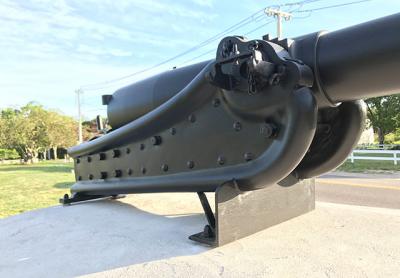The Return of the War Monument in Springs

Memorial Day weekend this year brought the return of a restored Civil War-era cannon to the green at Ashawagh Hall, where it sits atop the stone war memorial inscribed with the names of veterans from Springs. The cannon was removed two years ago and restored by James DeMartis, a Springs resident, metal sculptor, and blacksmith with a shop on Springs-Fireplace Road.
The Soldiers and Sailors Memorial on the Ashawagh Hall green was dedicated on May 30, 1925, to commemorate Springs residents who served in the Civil War and in World War I. On the speakers’ platform that day were Cornelius King and Israel Quaw, the hamlet’s only two surviving veterans of the Civil War. George Sid Miller chaired the memorial committee, and Barns Brothers of East Hampton did the masonry work on the monument.
Dennistoun Bell, whose property was in the area still known as the Bell Estate, toward Amagansett along Gardiner’s Bay, made a generous donation to help pay for the construction costs. The cannon was obtained from the federal government and transported to Springs at a cost of $16.28; the entire monument cost approximately $500.
The cannon and war monument had been restored in 1988 and 1989 by the Montauk Coast Guard at a cost of $6,000.
The Springs Improvement Society, which owns Ashawagh Hall, raised the money for that work. It was supervised by Ed Michels, an improvement society board member who was then with the Coast Guard. The flagpole, installed the same year as the memorial, also got some attention at that time — it was straightened, painted, and had its lines replaced.
With an effort by Heather Anderson, who is still involved in the Springs Historical Society and its Springs Library, a plaque was added to the monument with the names of Korean and Vietnam War veterans who were living in the hamlet when they entered the service.
By 2015, the supports for the barrel of the approximately one-ton cannon had rusted “to the point of collapse,” Mr. DeMartis said. Once he began the work, he noticed other parts of the steel structure that had rusted or even disintegrated.
With a little research, he found schematic drawings of identical cannons made in 1885 and was able to identify and reconstruct the missing parts.
The cannon, he saw, is a type called a “field rifle,” or “field cannon,” which originally was several feet longer and was carted onto the battlefield on a wagon, along with an ammunition cart and a portable forge for repairs.
It took almost two years for Mr. DeMartis and his crew to complete the restoration. The Springs Improvement Society paid for materials, but the metalsmith donated his labor.
On May 18, Glenn Bennett, a Springs resident and owner of Bennett Marine, using a flatbed truck and a crane hoist, replaced the cannon on its monument. With a small ceremony on Sunday, the refurbished memorial was once again dedicated to those it commemorates, the onetime Springs residents who served in our country’s armed forces.
